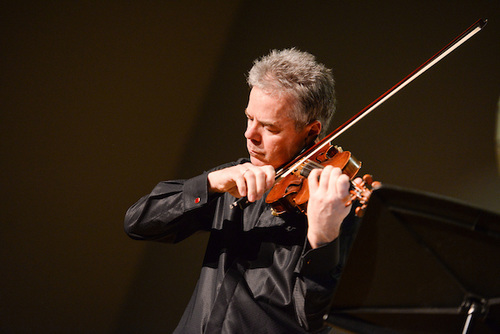Milwaukee Symphony Orchestra concertmaster Frank Almond gave audiences a rare chance to see and hear one of the world’s most famous musical instruments at the first concert of the 2014-15 Harker Concert Series season. The centuries-old Lipinski Stradivarius, which briefly went missing earlier this year after Almond was attacked following a performance, has a long and storied history, one that figured into the evening’s repertoire.
Rather than start with the music straight away, Almond opted to address the crowd on the history of the Lipinski and its connection to two of the pieces he would be playing. Giuseppe Tartini’s Violin Sonata in G minor, commonly known as “The Devil’s Trill,” was a fitting choice as the first piece of the evening, he explained, as Tartini was the Lipinski’s first known owner.
That the sonata has a reputation for being technically challenging might not have been obvious from its somber, almost weepy first movement, as Almond brought out the warmth of the Lipinski before launching into the stately and quick second movement. Jeffrey Sykes’ precise (but not robotic) piano accompaniment may have been easy to miss amidst the note flurries and wide intervals, but it nevertheless provided the ideal backing for Tartini’s most widely known work.
When it came time for the sonata’s third movement, Almond proved more than up to the task of traversing it. Among the more impressive and moving displays of the evening was an unaccompanied section consisting almost entirely of treacherously difficult double stop trills, handled so well that any thoughts of the virtuosity involved all but vanished.
Impressive though it was, it seemed almost like a warmup for Almond’s rendition of Bach’s legendary Chaconne from Partita in D minor. A marvel of sheer creativity, the chaconne begins with a simple four-measure theme that is taken through dozens of variations, resulting in a piece that for centuries has been hailed for its emotional and structural depth. Bach’s vision was served well by Almond’s masterful hands, which beautifully manipulated the Lipinski to illustrate the uniqueness of each variation and how they combine into a brilliant whole.
The Röntgen family, Almond told the audience in his introductory talk, purchased the Lipinski Stradivarius after Karol Lipinski’s death. One of the sons, Julius, went on to become composer and pianist of some renown, with a close association to Johannes Brahms. The bittersweet first movement of his Sonata No. 2 for Violin and Piano feature Almond’s delicate playing floating atop Sykes’ dancing piano melodies, evoking a pastoral serenity. The frolicking second movement, with its playful call-and-response staccato lines, continued in this vein before making way for the contemplative third movement, which wavered between the solemn and triumphant, building momentum for a thundering emotional climax of crashing chords and piercing high notes, which the Lipinski sang beautifully.
Harker parent Prashant Fuloria (Anika, grade 6; Varun, grade 3) enjoyed the performance of the Bach piece in particular and said that the concert’s atmosphere was a good environment for many age groups. “It’s not too formal. Kids can go around and be kids and listen to some great music,” he said.
“It is breathtaking,” attendee Lynn Mitchell said of Almond’s performance. “I particularly enjoy the Röntgen piece.” She also enjoyed the “inviting” atmosphere of the venue, and said the food was “delicious.”
The ostensible final piece for the evening was Cesar Franck’s Sonata in A Major, which was chosen, Almond said, because “it’s fun to play.” Sykes set the tone with a soft bedding of chords before being joined by the violin, whose vulnerable melodies were gorgeously rendered as they swayed rhythmically with the backing piano, the two trading melancholic lines. An urgent, almost sinister assemblage of piano notes opened the next movement before bursting into a dazzling run. Almond expertly utilized the Lipinski’s warm lower registers to introduce the frantic, flowing melody, which both contrasted and played off of the panicked piano underneath. The slow and repentant third movement was beautifully anchored by Sykes’ emotive subtleties, punctuated by anguished outbursts. As if to make up for the anxiety and despair of the previous two movements, the sonata shifted into an uplifting and determined mood, bringing back the theme from the first movement for a rollicking finish.
Shortly after showing their immense appreciation for Almond’s performance, the audience was treated to an encore performance of one of Clara Schumann’s Romances, a double rarity in that Schumann’s pieces are not widely performed, much less on a legendary 300-year-old instrument. Almond and Sykes’ rendering of the piece by the legendary pianist and gifted (but unfortunately unprolific) composer was as lovely as one could have expected, its reflective melodies providing a fitting sendoff for the evening.
